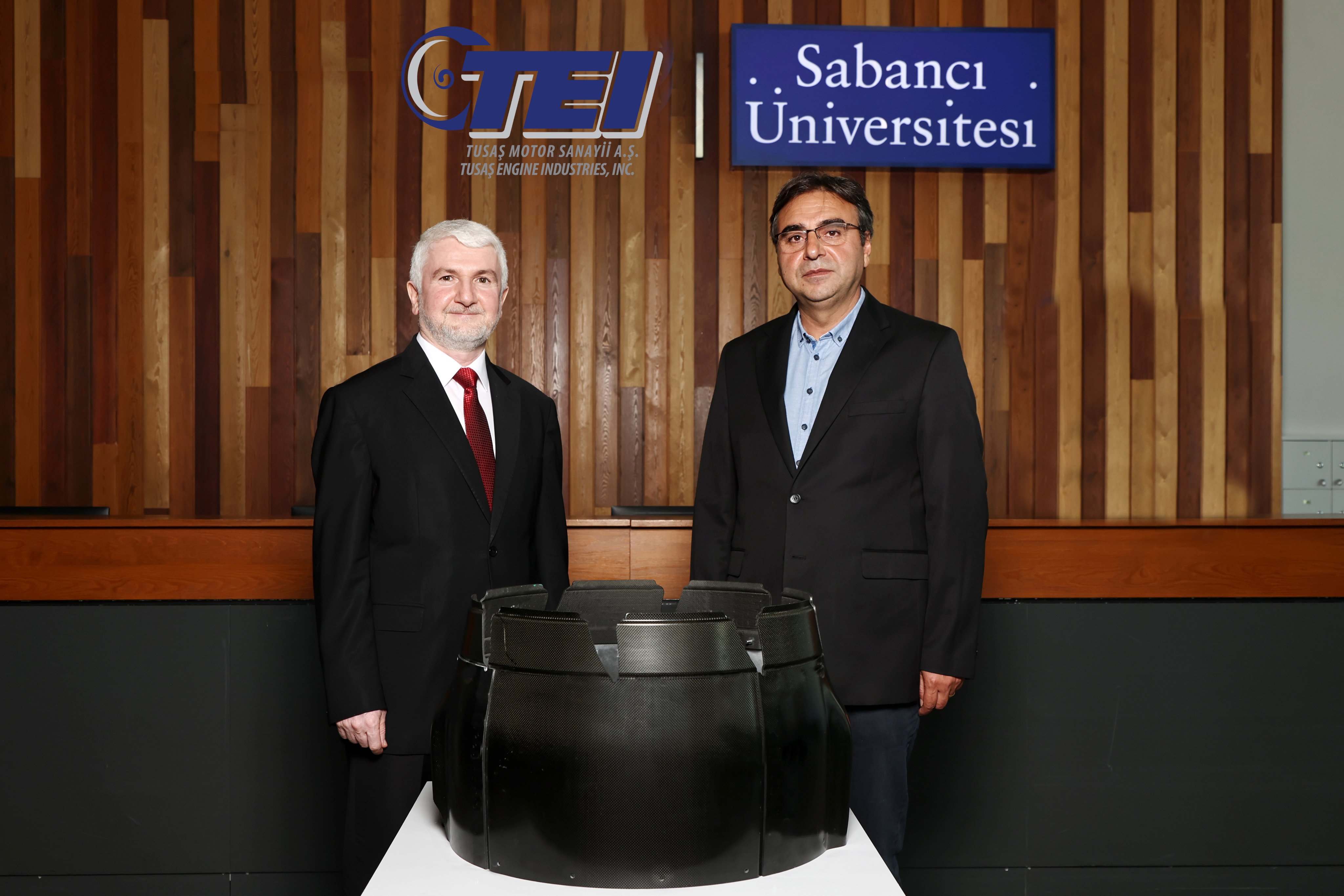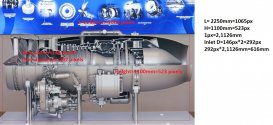I doubt that it would reach LEAP levels of efficiency. Maybe CFM-56 Level?If TEI manages to complete the TF6000, it can use the core to create a HBR equivalent to the IHI XF5-1 and IHI F7 combo. When the indigenous engine for the Kaan is completed, they can perhaps make a LEAP equivalent out of it.
You are using an out of date browser. It may not display this or other websites correctly.
You should upgrade or use an alternative browser.
You should upgrade or use an alternative browser.
Turkey Military News, Reports, Data, etc.
- Thread starter Jeff Head
- Start date
With TEI experience in producing parts for the LEAP and other HBR engines, and CMC being researched by TEI, Tubitak and Turkish universities, they might very well reach that level eventually. Will take some time though.I doubt that it would reach LEAP levels of efficiency. Maybe CFM-56 Level?
More turbofan engine development from Turkiye by TEI and universities:
TEI signed contracts with Sabancı University under the project named “Development of Fan Inner Casing System from Composite Materials for the Turbofan Engines”
And delivered!

Sabancı University delivers composite inner casing part for TEI's new jet engine TF6000And delivered!

TEI took delivery of the Fan Duct Inner Case (Fan Duct Inner Case), which was designed and developed by Kordsa at the Integrated Manufacturing Technologies Research and Application Center (SU IMC) operating within Sabancı University for the TEI-TF6000 Turbofan Engine, for the first time in Turkey, and manufactured from composite material.
The fan inner case system, which will be used in the TEI-TF6000 Turbofan Engine, enables a lightweight engine design thanks to the use of composite material. With the high strength advantage provided by the composite material, TEI will offer a competitive solution in the national turbofan engine.
Akşit: "Main inputs are local"
Speaking at the delivery ceremony held in Istanbul, TEI General Manager Prof. Dr. Mahmut F. Akşit pointed out that the manufactured part was a first in Turkey, and emphasized that the main inputs of the composite material used in its production, such as epoxy, were also domestic:
"As TEI, we continue our projects intensively. We are able to procure some of the parts we need through this method, which is a good example of university-industry cooperation. In this way, the centers also continue their activities. One of our next collaborations may be the production of front bearing structure blades used in aviation engines from composite materials. I would like to thank all the teams who successfully completed the project in less than a year."
Yıldız: Contributing to Turkey having a say in aviation
Speaking at the ceremony, Sabancı University Vice Rector for Research and Development Prof. Dr. Mehmet Yıldız said, "As Sabancı University, we attach great importance to university-industry collaborations. Especially in our Composite Technologies Center of Excellence, which is a pioneering business model in the industry, we carry out important studies with many companies.
We have been working with TEI on additive manufacturing for a long time. In this context, we have recently realized another project that enables the use of composite materials in the aviation industry. We are proud to contribute to Turkey having a say in the aviation industry in the world with this project. In addition to this project, we plan to continue our cooperation with TEI."
The project to develop a fan inner casing system made of composite material in turbofan engines was signed between TEI and Sabancı University at SAHA EXPO 2022. In the project, the design, development and manufacturing of the composite fan inner casing system, which will be used for the first time in a turbofan engine in Turkey, was successfully completed.
Karaok ATGM won a tender in Malaysia. 18 launcher units and more than 100 missiles will be provided:
I've updated it somewhat:I calculated the inlet diameter of the TF6000. I came out at 616mm:
View attachment 118106
Feel free to use this image wherever.
@Radonislav

Come to this side brother!You think I wouldn’t get a room with a WS-15 engine if I could? Blame the government for this not me. I’ve held it in for long enough!
I want to believe that you’ve seen me tortured over the years long enough to tolerate this rare indulgence!
The Turks will have their WS-15 in no time!
I've been doing some guesstimate work on how much time the engine for the Kaan will take from start of design to start of serial production by using statements from officials and the timeline of the TF6k/10k engine.
According to Aksit, the TF6000 design started in ~June 2020 and was finished in June 2022 when it was first revealed to the public. In October 2022 he stated that they are trying to produce the engine in one year:
Recently, he said that they plan to start the engine by the end of this year. That means 3,5 years from start of design to first ignition. Bear in mind that they suffered some delays because of Covid related issues, especially on the part of the engine accessories as they were to be imported from abroad. Earlier Aksit said that they planned to start the engine in Q1 of this year.
Engine testing on the ground will probably take around 2 years and flight testing another 2 years before serial production. All in all it will take 7,5 years for the TF6000 to be ready for serial production. Add another half year for the TF10000 (planned to finish building it by end of this year), and we are looking at 8 years of designing and testing for a low bypass ratio, afterburning turbofan engine, that is, without too much delay and problems.
Seeing as the TF6k/10k engine wil be a technology demonstrator for the Kaan engine, one can add another 2 years of design and test time because of additional capabilities that that engine must have. E.g. stealth nozzles, stealth afterburner section and supercruise capability.
This corresponds with the 2030 delivery plan of the Kaan with indigenous engine to the Turkish air force, as the design of the engine started in 2020 according to Kotil. All in all, it'll take 10 years for the engine to be ready for serial production from start of the project.
Kaan engine (TF-141?) timeline:
Preliminary design started: 2020
Detailed design started: 2023
Fist ignition planned and start of ground testing: 2026
First flight on Kaan planned : 2028
First delivery to air force planned: 2030
There is still 3+ years left till first ignition. If by that time, the Turkish engine industry is capable of building the engine accessoires in-house as they eventually did for the TS1400 and will do for the TF6000, than to build the engine won't take longer than one year, shorter than the production time of the TF6000. That leaves 2+ years to finish the detailed design of the engine.
Revised timeline:
Preliminary design started: 2020
Detailed design started: 2023
End of detailed design and start of part production: 2025
Fist ignition planned and start of ground testing: 2026
First flight on Kaan planned : 2028
First delivery to air force planned: 2030
All in all, the TF6k/10k progress will be the indicator of the Kaan engine as stated by TEI:
With the TEI-TF6000 project, TEI aims at carrying out the design, development and manufacturing stages of the Turbofan Engine, accessory subsystems, fan module, variable fixed blade compressor, flow mixer exhaust, afterburner for the first time in Türkiye, and achieve ground breaking technology, local supplier industry companies, and experienced human resource in our country.
With the TEI-TF10000 project, Türkiye will be indigenously realizing the critical technologies regarding the afterburner turbofan engine for the first time. National companies are planned to be used for the engine accessories and sub-systems. Within this scope, it is aimed to gain knowledge and experienced manpower both at TEI and its subcontractors.
According to Aksit, the TF6000 design started in ~June 2020 and was finished in June 2022 when it was first revealed to the public. In October 2022 he stated that they are trying to produce the engine in one year:
Prof. Dr. Mahmut F. AKŞİT: With such large engines, manufacturing the first prototype especially takes a significant amount of time because you need to write CNC codes for individual models of all parts and test sample pieces. You also prepare molds when necessary. You can proceed to manufacture actual materials after validating that the software processes everything at the desired size. It takes quite a while to do this for hundreds of parts. Manufacturing engineering is also very important here. It normally takes at least two or three years. We are currently trying to fit the whole process into one year.
Recently, he said that they plan to start the engine by the end of this year. That means 3,5 years from start of design to first ignition. Bear in mind that they suffered some delays because of Covid related issues, especially on the part of the engine accessories as they were to be imported from abroad. Earlier Aksit said that they planned to start the engine in Q1 of this year.
Engine testing on the ground will probably take around 2 years and flight testing another 2 years before serial production. All in all it will take 7,5 years for the TF6000 to be ready for serial production. Add another half year for the TF10000 (planned to finish building it by end of this year), and we are looking at 8 years of designing and testing for a low bypass ratio, afterburning turbofan engine, that is, without too much delay and problems.
Seeing as the TF6k/10k engine wil be a technology demonstrator for the Kaan engine, one can add another 2 years of design and test time because of additional capabilities that that engine must have. E.g. stealth nozzles, stealth afterburner section and supercruise capability.
This corresponds with the 2030 delivery plan of the Kaan with indigenous engine to the Turkish air force, as the design of the engine started in 2020 according to Kotil. All in all, it'll take 10 years for the engine to be ready for serial production from start of the project.
Kaan engine (TF-141?) timeline:
Preliminary design started: 2020
Detailed design started: 2023
Fist ignition planned and start of ground testing: 2026
First flight on Kaan planned : 2028
First delivery to air force planned: 2030
There is still 3+ years left till first ignition. If by that time, the Turkish engine industry is capable of building the engine accessoires in-house as they eventually did for the TS1400 and will do for the TF6000, than to build the engine won't take longer than one year, shorter than the production time of the TF6000. That leaves 2+ years to finish the detailed design of the engine.
Revised timeline:
Preliminary design started: 2020
Detailed design started: 2023
End of detailed design and start of part production: 2025
Fist ignition planned and start of ground testing: 2026
First flight on Kaan planned : 2028
First delivery to air force planned: 2030
All in all, the TF6k/10k progress will be the indicator of the Kaan engine as stated by TEI:
With the TEI-TF6000 project, TEI aims at carrying out the design, development and manufacturing stages of the Turbofan Engine, accessory subsystems, fan module, variable fixed blade compressor, flow mixer exhaust, afterburner for the first time in Türkiye, and achieve ground breaking technology, local supplier industry companies, and experienced human resource in our country.
With the TEI-TF10000 project, Türkiye will be indigenously realizing the critical technologies regarding the afterburner turbofan engine for the first time. National companies are planned to be used for the engine accessories and sub-systems. Within this scope, it is aimed to gain knowledge and experienced manpower both at TEI and its subcontractors.
Last edited:
